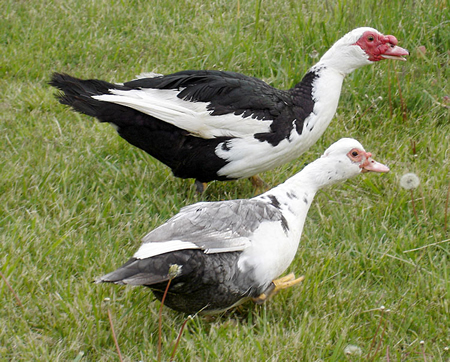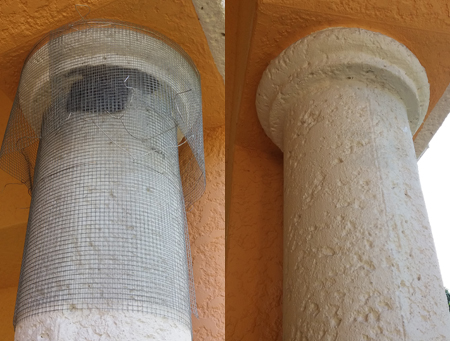Professional Wildlife Removal Services
- Inspection of property: perimeter, roof, and attic to find entry points.
- Humane trapping for 7 days to remove all wildlife.
- All animals are relocated to non-populated areas at least 20 miles away so they cannot return.
- Permanent closure of all entry points with all work guaranteed.
- Reasonable flat rate fees for all work done makes us the best value in the industry!
What you should know about nuisance wildlife and critters
- Alligators
- Armadillos
- Bats
- Bees
- Feral Cats
- Muscovy Ducks
- Opossums
- Otters
- Raccoons
- Rats
- Skunks
- Snakes
- Squirrels
- Woodpeckers
Alligators

Persons with concerns about an alligator may call FWC's toll-free
Nuisance Alligator Hotline
at
1-866-FWC-GATOR (866-392-4286)
Generally, an alligator may be deemed a nuisance if it is at least four feet in length
and the caller believes it poses a threat to people, pets or property.
Armadillos
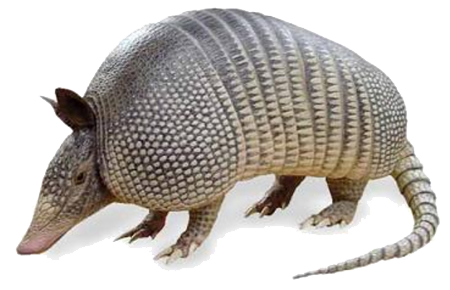
Appearance
The nine-banded armadillo (Dasypus novemcinctus), named for the nine breaks in the creature's leathery armor that allow it to flex its stiff hide, is an odd-looking mammal about the size of a cat.
Habitat
Armadillos are not native to Florida, but are now common over most of the state. Armadillos like forested or semi-open habitats with loose textured soil that allows them to dig easily. They eat many insects, or other invertebrates, and some plants. They most often feed at night, and have very poor eyesight.
Behavior
Armadillos dig burrows for homes or to escape predators, and a single armadillo can have several different burrows with multiple entrances. A mature armadillo is 15 to 17 inches long (not counting the tail) with a weight of eight to 17 pounds. Pregnant females always give birth to identical quadruplets. She produces one egg that splits into four identical offspring that are either all female or all male. This trait differs from most other mammals.
Armadillos are fascinating in other respects. When they need to cross narrow water bodies, they often walk on the bottom under water. If it is a wide body of water, they will inflate their stomach to twice its normal size, allowing for enough buoyancy to swim across. When startled, armadillos often leap high into the air, and then run quickly to a nearby burrow.
Armadillos prolific rooting and burrowing can severely damage lawns and flower-beds. To reduce armadillo damage to your lawn keep watering and fertilization to a minimum. Moist soil and lush vegetation bring earth worms and insect larvae (armadillo candy!) to the surface of the soil. Armadillos can sometimes be enticed to move by watering areas adjacent to the damage site. Also, watering gardens in the morning is preferable since the soil can dry out in the afternoon and not be as easily detected by night-foraging armadillos. Armadillos can also be excluded from small areas of extensive damage with fencing at least 2 feet high and with bottom buried at least 18 inches deep.
(Source: Florida Fish and Wildlife Conservation Commission)
We inspect the property for the animal entry points, trap all armadillos over a 10 day period, close the entry points so no new armadillos can enter, and add a deterrent.
Bats
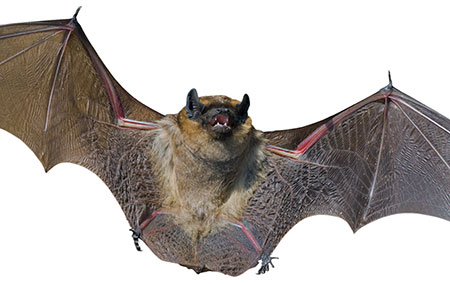
Call Professional Wildlife Removal today to have us do an inspection and provide a FREE estimate.
(239) 471-6285
All work is guaranteed.
Appearance
Bats belong to the order Chiroptera, which means "handwing". They are the only mammal that can truly fly. Florida has 13 resident bat species. Contrary to popular belief, bats are not blind. Their vision is adapted for low light levels. However, bats can maneuver in complete darkness using echolocation. Echolocation is the use of sound waves to detect objects. Bats emit high pitched sounds and listen for them to echo back. The length of time it takes the echo to return tells the bat how far away it is from an object. This allows the bat to fly in the dark and hunt for food. Bats' feet are uniquely adapted for grasping structures so that they can rest while hanging upside down. Bats undergo a state of torpor in the daytime; their heart rate and body temperature decrease so that they can conserve energy. Because of this, bats are reluctant to fly in the daytime even when disturbed. If they are forced to fly, they must first raise their body temperature and heart rate.
For their size, bats have the longest lifespan of any mammal. Some can live for more than thirty years.
Habitat
Bats live in many different habitats across Florida. They can be found from sandhills to the hardwood forests along the banks of rivers, and probably even in your neighborhood! For bats, one of the most important parts of their habitat is an area to roost. Some bats, like the Brazilian free-tailed bat, the evening bat, and the big brown bat are colonial, meaning they gather together in a colony to roost during the day. Other species, like the Seminole bat and the tricolored bat, are solitary, meaning that they roost by themselves. In Florida, natural roosting sites can be cracks, crevices, and hollows of trees, caves, dead fronds of palm trees, Spanish moss, and tree foliage. Bats also use manmade structures including buildings, bridges, culverts, tile roofs, and bat houses.
Behavior
Florida's native bats are insectivorous, meaning they eat insects including beetles, mosquitoes, moths, and other agriculture and garden pests. In fact, bats are the most important controller of night flying insects because a single bat can eat hundreds of insects a night!
In Florida, bats mostly mate in the fall and winter. The female does not usually ovulate until the spring when the insect population increases, but she can retain sperm for months before ovulation occurs. Most female bats only have one pup per year. For their size, bats are the slowest reproducing mammals. Pregnant females of some species will gather together in nursery colonies. Bats do not build nests. They normally give birth from mid-April through July, and their young begin to fly within 3 to 6 weeks. Juveniles are then weaned from their mothers and by mid-August the young are able to forage and fly on their own. Bats will not reach reproductive maturity until they are about one year old. This is considerably longer than most small mammals.
(Source: Florida Fish and Wildlife Conservation Commission)
Bats CANNOT be removed from April 15th-August 15th due to Florida State law.
All removal needs to take place between August 16th-April 14th.
Inspecting, deterrent netting, and exclusions can take anywhere from 2-14 days depending on how quickly the bats vacate the property. This is frequently covered by HOMEOWNERS INSURANCE and only requires you to pay your deductible.
Bees
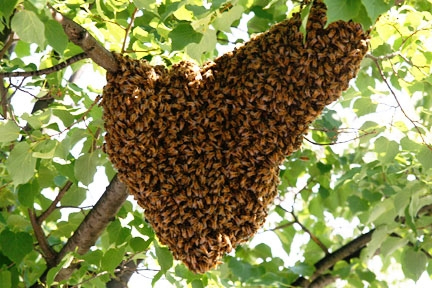
Call Professional Wildlife Removal today for a FREE estimate.
(239) 471-6285
All work is guaranteed.
Stinging Florida bugs such as bees are irritating to the average person and very dangerous to those who are allergic to them. Mosquitoes, wasps, and bees are usually responsible for a sting from a winged insect. Honeybees, species apis mellifera, which are common in Florida, produce a painful sting and usually do so in defense or if one of their nests has been disturbed.
Honeybees are normally furry, and easily recognizable by the yellow and black bands on their abdomen. They are about a 1/2" in length, with a head, a thorax or mid section, and an abdomen. The thorax has six legs and two wings, while the breathing sacs, poison gland and stinger are located on the rear of the abdomen. Bees die after they sting, leaving their stinger and venom sacs attached, which continue to release venom until the sac is emptied or the stinger is removed.
Wasps, order Hymenoptera, are generally 1-2 inches long, slender, narrow-waisted with long legs and are usually reddish-orange to brown or black in color. They also appear smooth-skinned and shiny. Unlike bees, which can only sting once before dying, wasps can sting repeatedly and will often do so if they feel threatened or if they are defending their nest. However, they are not overly-aggressive and will not attack humans unless provoked. Only females have the ability to sting.
(Source: Florida Bugs)
We inspect the property for bees, remove the hive whenever possible, and close up entry points if an opening is present. All Africanized Killer Bees and Wasps are euthanized using a NON Chemical means.
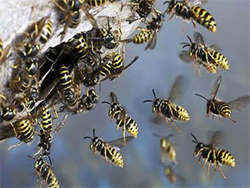
Feral Cats
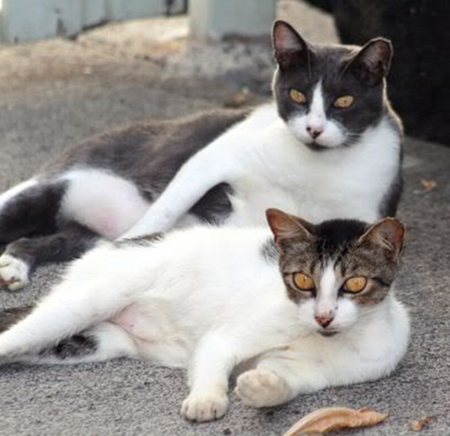
Contact Professional Wildlife Removal for possible feral cat removal.
(239) 471-6285
Background Information
The domestic cat (Felis catus) is a beloved house pet, with over 77 million pet cats nationwide. Of these, about 43 million spend some time outside. Additionally, there may be 60 to 100 million homeless stray and feral cats. Domestic cats are becoming a common feature not only of our backyards and city streets but also of our parks and other wild lands.
Domestic cats are descended from the wild cat of Africa and southwestern Asia and were domesticated by the Egyptians about 4,000 years ago. Animal behavior experts note that cats will hunt and kill even if well fed. Domestic cats are very effective predators on rabbits, squirrels, mice, lizards, snakes, and many species of wild birds.
Domestic cats can have impacts on native wildlife
- Domestic cats are not a part of natural ecosystem. A single individual free-ranging cat may kill 100 or more birds and mammals per year. Scientists in Wisconsin estimate that cats kill at least 7.8 million birds per year in that state alone. Even cats with bells on their collars kill birds and small mammals.
- Cats compete with native predators and spread disease.
- Domestic cats can be a nuisance and cause damage in many of the same ways that wild animals do, such as killing poultry and other small domestic stock.
- Homeless cats may compete with pets for food.
- Free-ranging cats can kill birds at bird feeders.
- Cats can be a nuisance in gardens when they defecate and cover their feces by digging.
(Source: Florida Fish and Wildlife Conservation Commission)
Feral, domestic muscovies are abundant in Florida, particularly in residential and park situations. These birds were released primarily by private individuals for ornamental purposes or as pets. Domestic muscovies continue to create nuisance problems throughout the state. To our knowledge, no populations of wild-strain muscovies have been established in Florida.
Muscovies are protected by Florida Statute 828.12 regarding animal cruelty. However, because these birds originated in Florida from domestic stock, they are not considered "wildlife".
As of March 31st, 2010 a federal control order is in effect that allows control by landowners, wildlife management agencies, and tenants, agents, or employees without federal or state permits, and prohibits the release of muscovies. Muscovy ducks have been introduced into urban and suburban areas in Florida where they often occur in high densities. Muscovies can be extremely prolific, and local populations, if uncontrolled, can increase dramatically in a short time. As a result, controversies frequently arise between residents who enjoy the birds and residents who consider them a nuisance.
Muscovy ducks, like other domestic animals, are considered private property. If someone claims ownership, the birds are the owner's to do with as he or she pleases, so long as Florida Statute 828.12 regarding animal cruelty is not violated. Similarly, if the muscovies have no owner, no state or federal law prohibits their capture and humane euthanization. This can be a last resort to resolve a nuisance problem.
(Source: Florida Fish and Wildlife Conservation Commission)
Opossums
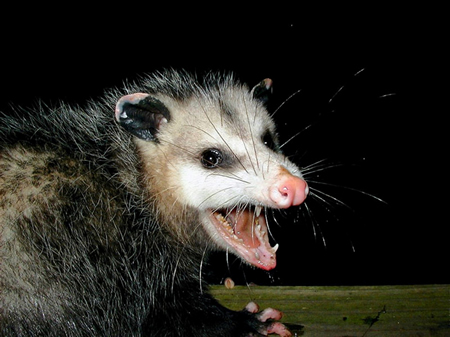
Call Professional Wildlife Removal today for a FREE estimate.
(239) 471-6285
All work is guaranteed.
Appearance
Florida's only marsupial (a mammal of the order Marsupialia having a pouch containing the mammary glands and serving as a receptacle for the young) is the Virginia opossum (Didelphis virginiana). Opossums are about the size of a house cat, have long naked tails and small ears.
Habitat
Opossums are attracted to virtually any type of available food, including garbage, pet food, or cultivated fruits and vegetables. To prevent attraction of opossums garbage cans should be secured with rubber straps, and pet food should be taken in at night.
(Source: Florida Fish and Wildlife Conservation Commission)
We inspect the property for the animal entry points, trap all opossums over a 7 day period, close the entry points so no new opossums can enter, and add a deterrent
Otters
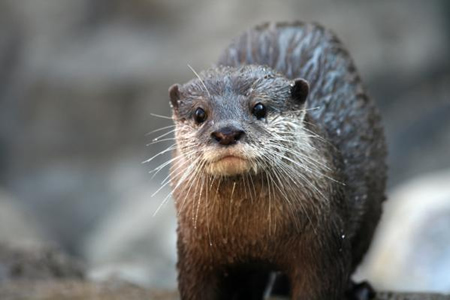
Call Professional Wildlife Removal today for a FREE estimate
(239) 471-6285
We guarantee all work.
Appearance
The river otter (Lutra canadensis) is a long, elongated water-loving animal found throughout Florida except the Keys. Its legs are short and has webbed toes for swimming. The ears are appear large on it's small flattened head.
Otters have five toes but occasionally only four show in the track. The heel pad tends to be somewhat "horseshoe" shaped.
Habitat
River otters seem to prefer fresh water, and can be in rivers, creeks, lakes, ponds, and swamps. Otters live in burrows on the bank of the water body, often under the roots of a tree. They may dig their own burrow, or remodel the burrow of a beaver.
Behavior
They normally feed on animals such as crayfish and fish. If you have a fish pond an otter may find it.
The best way to control the otter is to exclude the otter from pond with fencing or a cover. This will also prevent other animals such as raccoons, or some birds from finding the goldfish, which are an easy prey item for many species.
(Source: Florida Fish and Wildlife Conservation Commission)
We inspect the property for otter evidence, trap all otters over a two week period, and add a deterrent to prevent new otters from entering the property.
Raccoons
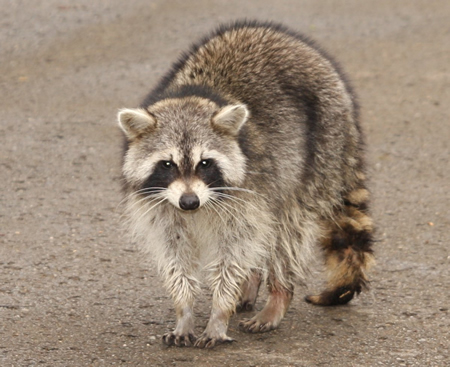
Call Professional Wildlife Removal today for a FREE estimate
(239) 471-6285
We guarantee all work.
Appearance
The raccoon (Procyon lotor) is about the size of a small dog, and is most notable for its black mask and bushy ringed tail.
Habitat
Raccoons are common throughout the state and occur everywhere there are trees, the cavities of which they often use.
Behavior
Raccoons are omnivorous feeding on fruits, plant material, eggs, crustaceans, small animals, and garbage. Raccoons usually become active in the late afternoon and throughout the night.
Problem raccoons are usually the result of chronic feeding by humans. Wild raccoons accustomed to being fed will generally lose their natural fear of humans and seek to move closer to their food source--your house. Once raccoons take up residence in your attic or outbuildings they can become very destructive and difficult to remove.
(Source: Florida Fish and Wildlife Conservation Commission)
We inspect the property for the animal entry points, trap all raccoons over a seven day period, close the entry points so no new raccoons can enter, and add a deterrent.
Rats
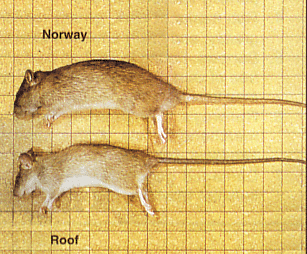
Call Professional Wildlife Removal today for a FREE estimate
(239) 471-6285
We guarantee all work.
The best and only really effective way to control rats and mice is to stop feeding them. Don't leave pet food out overnight or stock your platform or ground feeders with more than a day's worth of seed. Use rat- proof containers, such as garbage cans with tightly fitting lids, to store dry foodstuff. Situate brush piles well away from the bases of buildings.
Encourage rat snakes!
Remember that native rodents, particularly cotton rats, may be attracted to your yard. Unlike the unwanted Norway and black rats, our native species seldom occur inside buildings, don't pose a health threat, and can be fun to observe. They also are important foods to predators such as owls, hawks, and foxes. If you see rodents away from buildings or trash piles, they are likely beneficial, native species.
(Source: Florida Fish and Wildlife Conservation Commission)
We inspect the property for the animal entry points, trap all rodents over a 7 day period, close the entry points so no new rodents can enter, and add a deterrent so no new rodents enter the property.
Skunks
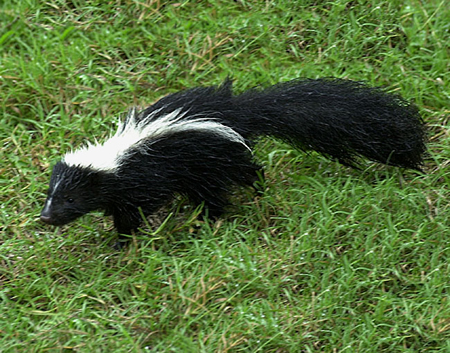
Call Professional Wildlife Removal today for a FREE estimate
(239) 471-6285
We guarantee all work.
Appearance
Both skunk species are about the size of a house cat with a small head, short legs, and a bushy tail.
Habitat
Florida is home to both the Eastern spotted skunk (Spilogale putorius) and the Striped skunk (Mephitis mephitis). They occur throughout Florida except for the Keys. Both species occur in brushy fields, weedy pastures, disturbed areas, and in residential and suburban areas.
Behavior
Skunks are usually active at night. Skunks are omnivorous, meaning they eat both animal and vegetable substances. They may be attracted by insects commonly found in lawns, fruit trees, gardens, or wherever food scraps are kept. They will den in vacant armadillo or gopher tortoise burrows (though they can dig their own) or brush piles, wood piles, areas with high grass, and similar sources of shelter.
Female skunks generally give birth to a litter of 4-7 babies in the spring. Newborns are blind and have very fine hair with the same black and white pattern as they would have as adults. When they are about six weeks old, the young follow their mother on food forays, searching for small mammals, insects, bird eggs, and amphibians, as well as roots, seeds, fruit and other plant parts. The mother and young stay together for several months, emerging from their underground burrows at night.
In addition to teaching their young how to find food, mother skunks also model defensive strategies, the most effective of these being a pungent spray of oily musk from scent glands located near the anus. The spray is effectively aimed at targets up to 15 feet away. The spray deters predators such as foxes, bobcats, coyotes and domestic dogs. Their chief predator is the great horned owl.
(Source: Florida Fish and Wildlife Conservation Commission)
We inspect the property for the animal entry points, trap all skunks over a 7 day period, close the entry points so no new skunks can enter, and add a deterrent.
Snakes
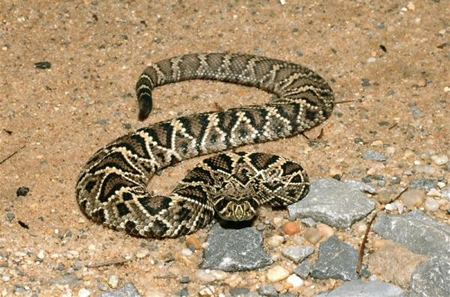
Call Professional Wildlife Removal today for a FREE estimate
(239) 471-6285
We guarantee all work.
Only four of Southwest Florida's 44 snake species are venomous, the eastern coral snake, the cottonmouth, the eastern diamondback rattlesnake, and the dusky pygmy rattlesnake. Most Florida snakes are harmless and beneficial and remove extra rodent populations. Even the venomous species are not particularly dangerous unless stepped on or otherwise provoked.
Most snakes you encounter are most likely to be nonpoisonous. By recognizing common non-venomous snakes and understanding something of their habits, you can take a more relaxed attitude toward them and appreciate them as an integral part of Florida's wildlife.
(Source: Florida Fish and Wildlife Conservation Commission)
If you are not sure what type of snake is on your property, call us for an over the phone identification.
We inspect the property for snakes and nesting, remove them when found, and give best tips for keeping new snakes off the property.
Squirrels
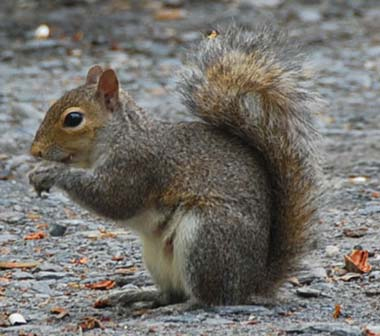
Call Professional Wildlife Removal today for a FREE estimate
(239) 471-6285
We guarantee all work.
Appearance
During late summer squirrels may be seen rolling on the ground, biting themselves, and jumping up and down. This is usually due to skin irritations from bot fly larvae, which are parasites that appear as bumps on the skin, often in places where the squirrel cannot scratch. The parasite is located only in the skin and does not affect edibility of the meat in harvested squirrels.
Habitat
Florida is home to three species of squirrels, the eastern gray squirrel (Sciurus carlinensis), the fox squirrel (Sciurus niger), and the southern flying squirrel (Glaucomys volans). The most common in urban areas is the eastern gray squirrel. Squirrels occur in woodland and urban areas, especially near oaks and hickories, and are active during the day, often feeding on the ground.
Behavior
Squirrels can cause problems by chewing on plants, tree bark and ornamentals as well as plastic items, like electrical wiring insulation or even wood siding on houses and out-buildings. It is often impossible or impractical to eliminate the source of their chewing. Potted plants can often be moved out of reach. PVC pipes and electrical wires can sometimes be covered with a insulation material that is soft and, therefore, less attractive to chew.
(Source: Florida Fish and Wildlife Conservation Commission)
We inspect the property for the squirrel evidence and trap all squirrels over a 7 day period.
Woodpeckers are one of the worst nuisance animal offenders due to the loud hammering sound they make on your house.
To attract a mate the male woodpecker does two things, hammers his bill at a surface that makes noise and attempts to open a hole to create a nest. Many homes in Florida have a foam-based decorative trim on their house that provides an opportunity for woodpeckers to attract and mate while causing major damage to your home. Many companies offer a very expensive hard coat over the foam trim but it is frequently pecked through and becomes a big waste of money.
We offer a clear repelling gel that is virtually invisible, keeps them away from your home, and is inexpensive. We also repair the damaged trim back to it's original condition.
